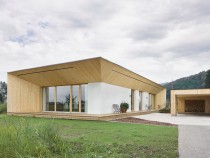
© Adolf Bereuter
On the outskirts of Dornbirn in Vorarlberg, Austria, on the edge of a low-density, single-family residential development, there is an unusual new building. The house has 120-centimetre-thick, white rendered walls supporting deep timber eaves that taper to the edge.
Concealed behind timber cladding and clay render is a material that makes this house unique in the region: straw bale. The bales serve as thermal insulation as well as a structural wall component. This unusual choice of material was the result of the client’s desire for a construction method that was both ecologically sound and extremely cost-efficient. So-called »jumbo bales« with cross-sections of 70 × 120 centimetres and lengths of up to 240 centimetres were stacked like giant masonry units and plastered with a three-centimetre layer of render.
Within the roof space the bales are held in prefabricated timber box girders, which rest on the outer walls and were secured together on-site to form a rigid roof plate. In the west and south, the deep overhang of up to 2.5 metres not only protects the interior spaces from the high rays of the summer sun, but also protects the straw bales from driving rain.
Concealed behind timber cladding and clay render is a material that makes this house unique in the region: straw bale. The bales serve as thermal insulation as well as a structural wall component. This unusual choice of material was the result of the client’s desire for a construction method that was both ecologically sound and extremely cost-efficient. So-called »jumbo bales« with cross-sections of 70 × 120 centimetres and lengths of up to 240 centimetres were stacked like giant masonry units and plastered with a three-centimetre layer of render.
Within the roof space the bales are held in prefabricated timber box girders, which rest on the outer walls and were secured together on-site to form a rigid roof plate. In the west and south, the deep overhang of up to 2.5 metres not only protects the interior spaces from the high rays of the summer sun, but also protects the straw bales from driving rain.









